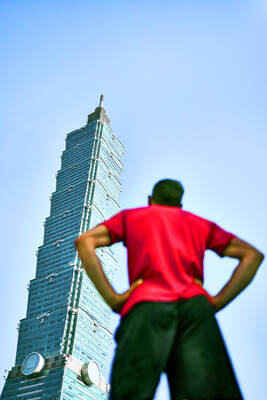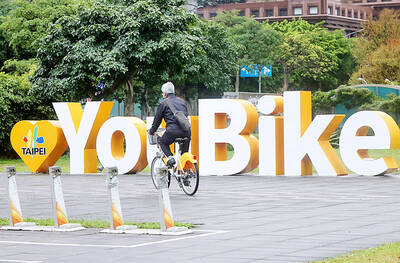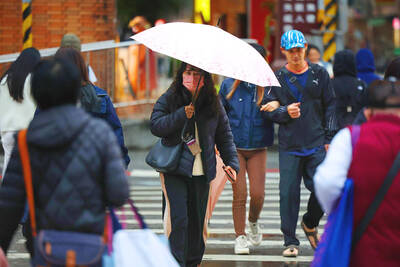The Ministry of Transportation and Communications yesterday unveiled its new proposed rates for the freeway “pay as you go” policy, with long-distance travelers facing higher toll fees than what they pay now.
Minister of Transportation and Communications Yeh Kuang-shih (葉匡時) and National Freeway Bureau Director-General Tseng Dar-jen (曾大仁) presented the new rates during a meeting of the legislature’s Transportation Committee.
However, before Yeh could start briefing the committee, Democratic Progressive Party Legislator Chen Ou-po (陳歐珀), representing Yilan County, occupied the podium and chided the ministry for mentioning nothing in its report about the Chiang Wei-shui Freeway (Freeway No. 5) that runs from Taipei to Yilan, adding that motorists in Yilan would end up paying higher toll fees under the ministry’s proposal.

Photo: Wang Yi-sung, Taipei Times
Dissatisfied with the ministry’s rate plan, he shredded a copy of the report into pieces and threw them at ministry officials.
“You are bullying the people of Yilan. You never came and explained the new rates to people in the county,” Chen said.
The meeting resumed after Chen left the podium after the convener of the meeting, DPP Legislator Lee Kun-tse (李昆澤), promised Chen that he could question the ministry later about the proposed rates.
The bureau had previously offered three rate plans. The first one would not give freeway users any toll-free distance, with each person being charged NT$0.82 per kilometer traveled. The second plan would give drivers 10km of toll-free distance, after which they would have to pay NT$1 per kilometer traveled. The third plan would give drivers 20km of toll-free distance, after which they would be charged NT$1.2 per kilometer if the entire distance traveled is less than 200km. The rate would drop to NT$0.9 per kilometer if the entire distance traveled is 200km or more.
However, the bureau decided to readjust the rates after legislators demanded that travelers on the east-west freeways, including Freeway Nos. 2, 4, 6, 8 and 10 not be asked to pay any toll fee at all.
As such, the three new sets of proposed rates were calculated based on the condition that motorists on the east-west freeways would not be asked to pay toll for two years. Under the first option, motorists will not enjoy any toll-free distance and will be charged NT$0.9 per kilometer. For the second option, motorists will enjoy 15km of toll-free distance and be charged NT$1.2 per kilometer if the total distance is less than 200km. The rate will drop to NT$0.9 per kilometer if the total distance exceeds 200km.
The third option will give motorists a toll-free distance of 20km, with the rate being set at NT$1.3 per kilometer if the distance traveled is less than 200km and NT$1 per kilometer if the distance is 200km and above.
If the third option is chosen, a motorist would have to pay NT$377 for driving from Taipei to Greater Kaohsiung, compared with NT$360 at present.
DPP legislators Kuan Bi-ling (管碧玲) and Tsai Chi-chang (蔡其昌) also questioned the ministry over the use of eTags, which reports said leak users’ information to other businesses.
They said the ministry should not introduce new toll rates until it has come up with measures to regulate how Far Eastern Electronic Toll Collection, the freeway toll-collection service contractor, manages personal information.
KMT Legislator Lin Ming-cheng (林明溱) suggested that the toll-free distance be set at 30km and the toll fee be set below NT$1 per kilometer.
A flustered Lin also slipped up when he said: “The ruling party will suffer a big loss in the next legislative election” if the ministry’s proposed rates are not changed.
The meeting ended without reaching a consensus.

US climber Alex Honnold is to attempt to scale Taipei 101 without a rope and harness in a live Netflix special on Jan. 24, the streaming platform announced on Wednesday. Accounting for the time difference, the two-hour broadcast of Honnold’s climb, called Skyscraper Live, is to air on Jan. 23 in the US, Netflix said in a statement. Honnold, 40, was the first person ever to free solo climb the 900m El Capitan rock formation in Yosemite National Park — a feat that was recorded and later made into the 2018 documentary film Free Solo. Netflix previewed Skyscraper Live in October, after videos

Starting on Jan. 1, YouBike riders must have insurance to use the service, and a six-month trial of NT$5 coupons under certain conditions would be implemented to balance bike shortages, a joint statement from transportation departments across Taipei, New Taipei City and Taoyuan announced yesterday. The rental bike system operator said that coupons would be offered to riders to rent bikes from full stations, for riders who take out an electric-assisted bike from a full station, and for riders who return a bike to an empty station. All riders with YouBike accounts are automatically eligible for the program, and each membership account

NUMBERS IMBALANCE: More than 4 million Taiwanese have visited China this year, while only about half a million Chinese have visited here Beijing has yet to respond to Taiwan’s requests for negotiation over matters related to the recovery of cross-strait tourism, the Tourism Administration said yesterday. Taiwan’s tourism authority issued the statement after Chinese-language daily the China Times reported yesterday that the government’s policy of banning group tours to China does not stop Taiwanese from visiting the country. As of October, more than 4.2 million had traveled to China this year, exceeding last year. Beijing estimated the number of Taiwanese tourists in China could reach 4.5 million this year. By contrast, only 500,000 Chinese tourists are expected in Taiwan, the report said. The report

Temperatures are forecast to drop steadily as a continental cold air mass moves across Taiwan, with some areas also likely to see heavy rainfall, the Central Weather Administration (CWA) said. From today through early tomorrow, a cold air mass would keep temperatures low across central and northern Taiwan, and the eastern half of Taiwan proper, with isolated brief showers forecast along Keelung’s north coast, Taipei and New Taipei City’s mountainous areas and eastern Taiwan, it said. Lows of 11°C to 15°C are forecast in central and northern Taiwan, Yilan County, and the outlying Kinmen and Lienchiang (Matsu) counties, and 14°C to 17°C